Introduction to the ALPHEUS Project

European goals for reducing greenhouse gas emissions require the increase of renewable energies used in the electric grid. Nowadays the most developed renewable energy technologies are wind, solar and hydraulic power stations. Wind and solar energy capacity has been rapidly increasing in the last years. However, the natural unpredictability of these energy sources calls for the addition of extra features to the grid.
Consider a winter windless day: the wind and solar energy stations cannot produce energy. Currently, when this happens, non-renewable energy sources are used to produce electricity. To avoid the use of the polluting energy sources, there are two main alternatives (at present):
- Increasing the grid’s transmission capacity: consider the previously-mentioned winter windless day. Probably in another region there is an excess of sun or wind energy that surpasses the consumption of that region. In that case, with an increase of the electric transmission lines, the electricity that is not locally consumed, can be transported to the places it is needed.
- Store energy: this allows to locally store excess renewable energy production, for instance during a summer windy day. Later, for instance a winter windless day, this energy can be converted into electricity.
Mainly, increasing the transmission capacity is time-consuming and expensive compared to energy storage. Energy storage is already being performed in a grid-scale, mainly by pumped hydro storage stations. When there is an excess of renewable energy being produced, this excess is used to pump water from a reservoir to a more elevated one (around 300 – 600 m of elevation difference). When electricity is needed, the water is drained through a turbine back to the lower reservoir, producing electricity in the process. With enough storage capacity, the turbines would provide electricity during the winter windless days of the previous example.
However, this kind of technology is not feasible in the low-lying countries such as the Netherlands, Belgium and Northern Germany. A possible solution would be to research whether pumped hydro stations can be installed in the North Sea. The difference with the previously mentioned stations is that the elevation difference between reservoirs is much lower (around 20 m). This concept is very innovative, it has never been built and less than 10 plans have been developed regarding this technology. The ALPHEUS project will look at the feasibility of low-head pumped hydro storage stations in the North Sea. Important aspects of the research are new pump-turbine designs, new power electronics, design of new and innovative powerhouses, law considerations and of course, sustainability and affection to the local flora and fauna.
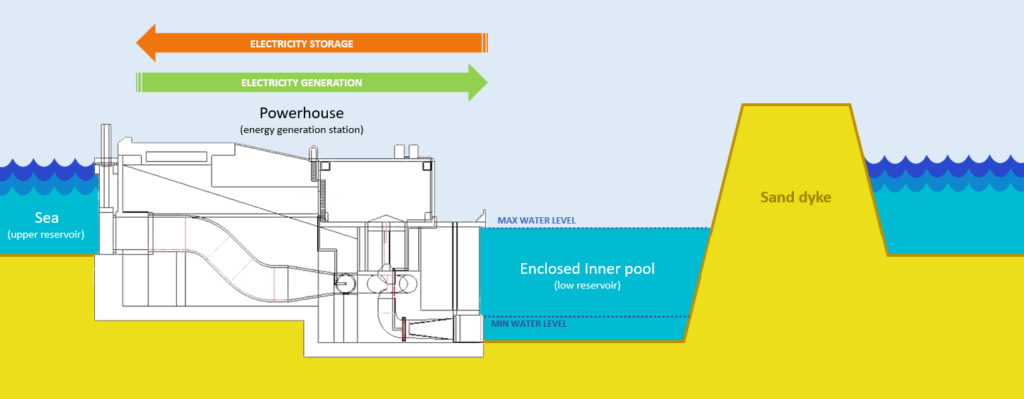
Introduction
Europe wants to become the first climate-neutral continent in the world by 2050. Already by 2030, the European Union plans to reduce greenhouse gas emissions at least 55% compared to 1990 levels. One of the targets defined to achieve this is to decarbonize the energy sector, i.e. introducing more renewable energy sources into the European grid. During the period 2008 – 2018, wind energy, solar energy, and solid biofuels technologies have rapidly grown, and wind power became the most important renewable source of energy in Europe1. Currently, renewable energy in the European grid is produced by wind power (36%), hydropower (33%), solar power (12%), solid biofuels (9%), and other renewables (9%).
However, as shown in this document, because of the natural unpredictability of the renewable energy sources (e.g. wind, solar) zero greenhouse gas emissions cannot be achieved by just increasing the amount of these energy sources. The inclusion of more renewable energy generation stations must be accompanied by new technologies to store energy and/or to distribute it between production sites and consumption hubs. To understand this, first this document presents you a summary of how the energy system works. Then, we will see the challenges that arise when increasing the renewable energy stations (e.g. wind and solar stations). Finally, we focus on how energy storage could help to solve these challenges, particularly the pumped hydro storage technology.
Energy System
The figure below shows the network used to generate and transport electricity to our houses, workplace, favorite stadium, etc. Electricity is produced on demand at the power stations (non-renewable sources such as: coal, gas, petroleum… or renewable sources such as: wind, solar, hydropower…) and then transported through a complex network of transformers and transmission lines to our homes. Electricity must be produced and used to power an electronic device. It cannot be stored (Think about a bike’s dynamo, without a battery, when the bike is not running there is no light). Thus, the produced electricity must follow the actual demand at each moment of the day.
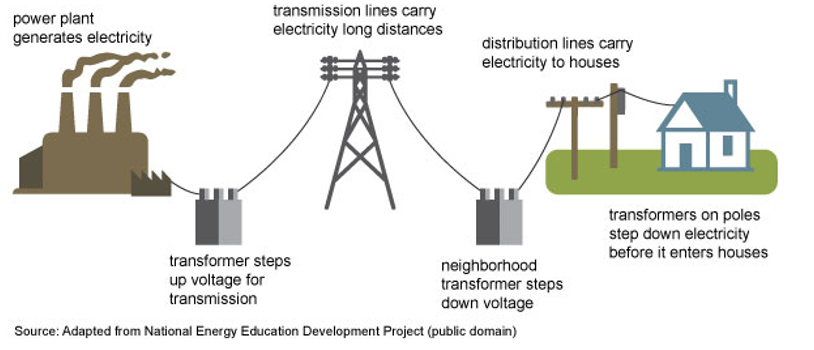
Source: https://www.eia.gov/energyexplained/electricity/delivery-to-consumers.php
Figures 2, 3 and 4 show this correlation between electricity generation (colored areas) and consumption (red line) during three different past days, taking Germany as an example. Comparing Figures 2 and 3, we can observe that during summer (Fig 2) there is a peak in energy use at the warmer hours (from 10:00 to 16:00) whereas in winter the energy use is more extended during the working hours (from 7:00 to 18:00). Additionally, we can see that for both days, the wind was blowing and thus a large share of electricity was produced with onshore wind power stations. During the summer month the available solar energy is much larger, which allowed for a lower use of fossil hard coal, brown coal and gas respecting the winter months.
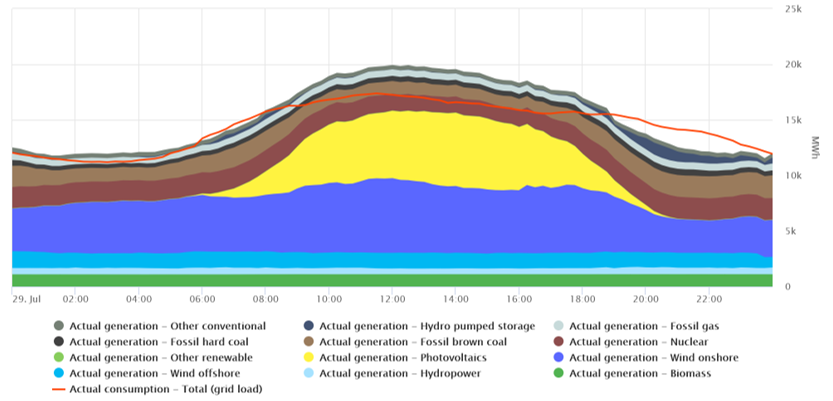
Source: https://www.smard.de/en
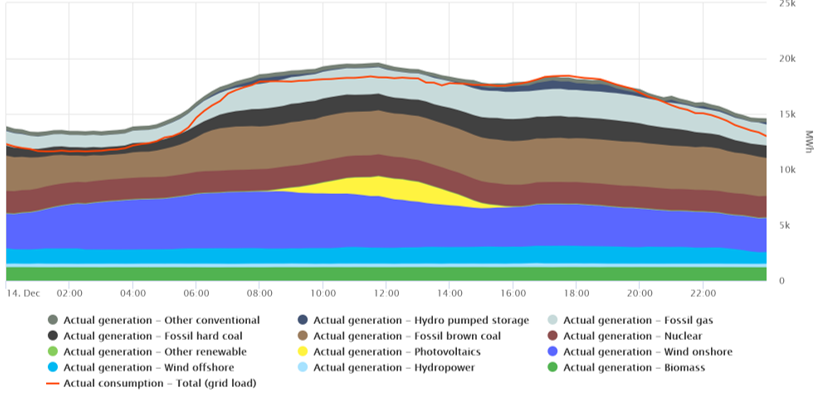
Source: https://www.smard.de/en
This is even more clear when comparing Figures 2 and 4, Figure 4 represents a winter day in which the wind was not blowing. Therefore, there was no opportunity to generate much wind energy and as a result, we can see that the most of the energy generated comes from coal and gas. This shows that just having electricity generation stations that are powered with wind and solar does not ensure to have a constant share of renewable energy throughout the year. When there is not enough wind or sun available, electricity cannot be produced from these sources. The power stations are still there, but there is simply no way of obtaining electricity from them. Thus, to meet the European goal of being a climate-neutral continent by 2050, we need a way to ensure the renewable energy supply over the year. As we will see below, energy storage and increasing the energy transmission lines can help cope with this issue.
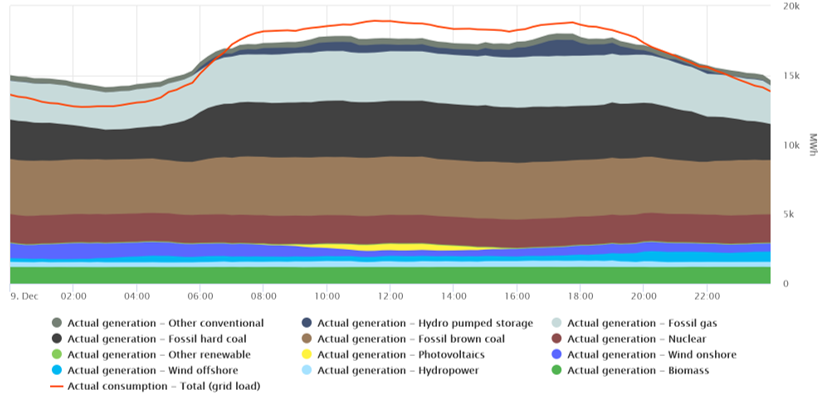
Source: https://www.smard.de/en
Increase of Renewable Energy within the Grid: Curtailment
The addition of large amounts of wind and solar energy stations to the grid, due to its unpredictable nature, may cause some issues in the electric grid. At times of large wind and solar energy production, the system operators may have to accept less wind and solar than it is available2. This is because the wind turbines and solar panels would be able to produce more electricity than the consumed one. But we cannot produce energy that cannot be used. Thus, either the wind turbines or solar panels (or both) stop working. This measure is called curtailment; a pause in renewable energy production. The EU’s Twenties project showed that large-scale offshore wind development could increase wind curtailment (the more wind capacity we install the larger the probability that during a windy day, some or several windmills must stop working because its electricity cannot be used).
Solving Curtailment
Lack of transmission capacity (i.e. capacity to transport the generated electricity via the grid) is the main factor by which curtailment occurs because when there is an excess of wind, the excess energy cannot be transported to other areas where it may be used3. Many approaches can be used to increase the transmission capacity of the grid, but to expand the existing transmission network is expensive and time-consuming4. An alternative is energy storage. Instead of taking the energy somewhere else, it can be locally stored for later use5. However, we already mentioned that electricity itself cannot be stored, we need to transform this electricity into another kind of energy (if the reader is interested, some examples are potential energy: pumped hydro storage, kinetic energy: flywheel, chemical energy: batteries).
To know more about the storage energy, we invite you to read this article.
Author: Ruben Ansorena Ruiz – PhD Researcher Student at TU Braunschweig

